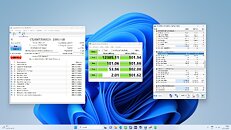- Joined
- Oct 9, 2007
- Messages
- 47,537 (7.47/day)
- Location
- Hyderabad, India
| System Name | RBMK-1000 |
|---|---|
| Processor | AMD Ryzen 7 5700G |
| Motherboard | ASUS ROG Strix B450-E Gaming |
| Cooling | DeepCool Gammax L240 V2 |
| Memory | 2x 8GB G.Skill Sniper X |
| Video Card(s) | Palit GeForce RTX 2080 SUPER GameRock |
| Storage | Western Digital Black NVMe 512GB |
| Display(s) | BenQ 1440p 60 Hz 27-inch |
| Case | Corsair Carbide 100R |
| Audio Device(s) | ASUS SupremeFX S1220A |
| Power Supply | Cooler Master MWE Gold 650W |
| Mouse | ASUS ROG Strix Impact |
| Keyboard | Gamdias Hermes E2 |
| Software | Windows 11 Pro |
Crucial T700, the company's flagship M.2 NVMe Gen 5 SSD, runs hot—like every other drive based on the Phison E26-series controller (such as the Corsair MP700). ComputerBase.de discovered what the drive does without some sort of cooling. The E26 controller has a Tjmax value of around 86°C, and what happens when it's reached depends on the drive in question. The Corsair MP700 can turn itself off to protect the controller—something that will definitely cause your machine to hang with a BSOD.
The Crucial T700, on the other hand, aggressively throttles down the controller in an attempt to lower temperatures. While the drive won't stop (and your machine won't hang), its performance drops to hard drive levels, with CrystalDiskMark (CDM) measurements pointing to around 101 MB/s (of course, with much lower access times than a HDD). Both Crucial and Corsair offer the drive with large heatsinks, and recommend users to use them. This should severely limit the adoption of Gen 5 NVMe SSDs among notebooks, where the notebook chassis has room for only bare drives. However, some OEMs specializing in larger high-end gaming notebooks and desktop-replacement workstations, can find ways to connect the drives to the notebook's main cooling system using flattened heatpipes. You can catch ComputerBase's review of the MP700 in the source link below.

View at TechPowerUp Main Site | Source
The Crucial T700, on the other hand, aggressively throttles down the controller in an attempt to lower temperatures. While the drive won't stop (and your machine won't hang), its performance drops to hard drive levels, with CrystalDiskMark (CDM) measurements pointing to around 101 MB/s (of course, with much lower access times than a HDD). Both Crucial and Corsair offer the drive with large heatsinks, and recommend users to use them. This should severely limit the adoption of Gen 5 NVMe SSDs among notebooks, where the notebook chassis has room for only bare drives. However, some OEMs specializing in larger high-end gaming notebooks and desktop-replacement workstations, can find ways to connect the drives to the notebook's main cooling system using flattened heatpipes. You can catch ComputerBase's review of the MP700 in the source link below.

View at TechPowerUp Main Site | Source








